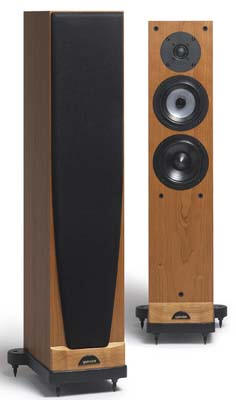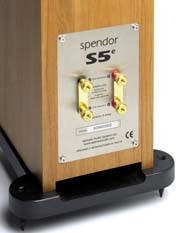Small and lightweight and good looking. These are the first impressions I had when unpacking and setting up the 2 ½ way Spendors. They were smaller in person than I expected them to be, measuring just 31.1 x 6.5 x 10.4 inches. If you recall the big Dunlavys and Duntechs, you are familiar with the tall-and-narrow format, although tall in this case is just thigh high. The S5e model weighs in at about 35 pounds. The real wood cherry enclosures are very well constructed and look good enough for installation in a living room or other shared space. Maple, rosenut, and black ash exteriors are also available. They are not grain matched, but are close.

There is a base included which places the rear adjustable spiked feet outside of the width of the cabinets. This helps to stabilize the lightweight speakers and tipping or other instability was never an issue. There is a rectangular port on the rear where the base and wood cabinet meet. More on this later. The speakers also include dual binding posts for bi-wiring, but the speakers were single-wired during the evaluation period.
The rest of the review system included Response Audio Bella Extreme 100 (100 watt tube) and EVS 500M (500 watt ICEpower solid state) power amplifiers, Placette Passive Line Stage and ModWright SWLP 9.0SE preamplifiers, EAR 88PB and Conrad Johnson Premier 15 Series 2 phono preamps, Kuzma Stabi Reference and SOTA Cosmos IV turntables with Origin Live Conqueror and Tri-Planar VII tonearms, and at the head of the chain, Zyx UNIverse, Benz Ebony LP and Koetsu Jade Platinum moving-coil phono cartridges. Interconnects were mostly PS Audio Resolution Transcendent used with Audience Au24 speaker cables. Comparison speakers included Gallo Reference 3.1 and Dynaudio Audience 60. Oh, and there was CD, too.
Rear ported speakers really don’t make sense to me. Bouncing part of the bass wave off of the rear wall, which the speaker designer cannot define – or control – as to material, rigidity, distance or size, creates a huge variable for good bass reproduction. This is very important because the length of bass waves, around 30 feet long or more, interact with the listening room to such a significant degree that the loudspeakers and the listening room together should be considered integral parts of the “bass system”. This does not mean that rear-ported speakers are necessarily inferior to front-ported designs, but that the presence of a “back door port” always makes speaker placement more critical in attaining good bass response.
I tried speaker placements from about 6” to 30” from the rear wall and was never totally satisfied that the bass was either as good as it might be or as it should be. The lower bass did not integrate properly with the higher resolution of the upper bass and lower midrange. The bass easily filled the 12 x 19 x 8 foot room with a good sense of energy, but the resolution was not in the same league as the upper bass, although it improved at higher listening levels. It was more of the “rolling thunder” variety than tight and articulate like the midrange is. The bass extended down to about 40 Hz, which is quite satisfying on almost all music. The bass quality improves significantly in the upper bass which is above about 80 Hz. Coincidently, this is the frequency where home theater systems cross over to the .5 channel subwoofer.
So I moved the Spendors to the HT system and tried the .5 configuration. This improved the upper bass even more, although I don’t really like that .5 crossover scheme. Instead, I prefer to set my Pioneer Elite VSX-36TX DTS/THX receiver to Full Range Front and not use the .5 channel at all. Then, I inserted tightly rolled packaging foam into the rectangular port (see image below) and let the pair of parallel connected Perfect Subwoofers take care of the lower bass through their high level inputs from the speaker terminals. Dialing in the two subwoofers was quick and easy using my tried and true method here. This not only solved any issue of low bass quality, but enabled the little S5es to play loud without strain in my 22 x 18 x 10 foot (~4000 cubic feet) living room.

To summarize the bass, there is only so much a 5” woofer can do, and considering the real challenge that confronts a speaker designer working with a 5” driver, the Spendor’s low bass performance is understandable. The ported design is a good compromise to keep the boxes small, and in the right environment, might perform perfectly.
Voices sound very clean and have low coloration. There is a small amount of forwardness just above middle-C, around 300 to 400 Hz. This can accentuate a “shouty” quality on some recordings, but never interferes with the unambiguous intelligibility of speech or vocals. A recurring but very small trace of overhang was noted (and which is probably connected with the shouty reference above), as if the midrange driver sometimes was not quite following the music signal precisely. This is most noticeable at moderate listening levels and lessened at higher levels. It was not significant enough to be an echo; a dim “shadow” would be a better description. The small forwardness could be a benefit on many recordings containing complex vocal arrangements by helping the listener to better differentiate multiple low level harmonies.
The midrange presents the acoustic guitar very believably. Simple strumming and plucking of the strings comes through very realistically. The upper midrange is very clean and free of artifacts, but never bleached of life. This offers excellent vocal clarity without sibilance or harshness. The overall clarity and articulation in the midrange is excellent in this price range and above.
The transition to the treble is generally good. I find the quality of the crossover from bass to midrange drivers to be important to musical enjoyment. On the other hand, the midrange to tweeter transition is absolutely critical and a poorly designed or executed tweeter crossover has marred the sound of many speakers. The Spendor crossover is quite good, but it was apparent that the tweeter has greater resolution in its lower frequency range than the midrange driver has in its upper range. This creates a small discontinuity in the sounds from the two drivers that is noticeable as instruments run up the scale from one driver to the next. Again, this is a small character and should be put in perspective given the S5e’s price.
The treble is excellent – no qualifiers. Cymbals sound like metal and not like white noise. The latter is disturbingly common even in speakers costing $10,000 or more. Low level resolution is excellent from the midrange up through the treble and is just shy of speakers which cost a great deal more. This notable clarity provides for a relaxed presentation of complex music so it never sounds confused. The Spendors give a very good sense of energizing the air the way esteemed reference speakers do, presenting a complete sonic picture. This is a character that combines excellent micro-dynamic performance with superb low level resolution. Both are required to “build-up” each note so it sounds real and convincing.
Large scale dynamic changes are handled just as well. Rim shots, the leading edge of notes, and other instantaneous changes of volume are always enjoyable and often startling. The feeling of good pace and timing is always present and makes listening to these speakers a pleasure. It is hard to sit still and just observe. Participation is a regular part of a listening session with the Spendors up front.
The imaging abilities of the narrow baffles are just what one would expect. The Spendors throw a wide and deep sound stage. There is very good center fill and also a convincing sense of the size of the recording venue. They provide a wide listening window with even frequency dispersion so you don’t need to stay seated in one particular sweet spot. You can move around and share the fun. The more I listened to these speakers, the more I appreciated how they perform when playing real music and not just how they differ from the reference speakers or rate on individual critical listening criteria. For $2000, you get a beautifully finished and very capable speaker that will fit easily into small or restricted (by spouse or decor) areas.
If it seems as if I have been overly critical of the Spendor S5e it is because they do so much so well – and well beyond their price – that their relatively minor shortcomings are more obvious. But don’t believe for a minute that I didn’t enjoy them every minute that they made music in my systems. In fact, I bought them, added a matching C5e center channel, and now enjoy them in the HT system where their excellent articulation of vocals and equally excellent macro-dynamic abilities provide a solid foundation for both movies and music.
Overall Rating: 8.5 LPs
Manufacturer’s Web Site: Spendor Audio Systems
